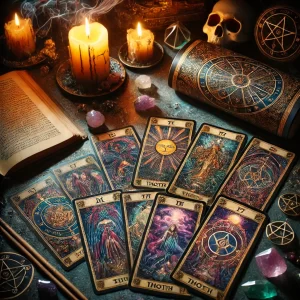 Unlocking the Mysteries: A Guide to Different Types of Tarot Cards and How They Work
Unlocking the Mysteries: A Guide to Different Types of Tarot Cards and How They Work
Tarot cards have been a powerful tool for spiritual guidance, self-reflection, and divination for centuries. With their rich symbolism and mystic allure, tarot decks serve as gateways to the subconscious, helping us uncover truths about ourselves and the paths before us. However, not all tarot decks are the same. From the traditional Rider-Waite to the ethereal Thoth deck, each type offers a unique lens for interpreting the messages of the universe. In this blog post, we will explore the different types of tarot cards and how they work to help you find the deck that resonates most with your spiritual journey.
1. The Rider-Waite Tarot: A Classic for Beginners and Experts Alike
Origin: Created in 1909 by A.E. Waite and illustrated by Pamela Colman Smith, the Rider-Waite deck is one of the most popular and widely used tarot decks worldwide.
Structure:
- 78 cards: 22 Major Arcana (representing life’s spiritual and karmic lessons) and 56 Minor Arcana (depicting day-to-day challenges).
- The Minor Arcana is divided into four suits: Cups, Pentacles, Swords, and Wands.
How It Works: The Rider-Waite deck is renowned for its straightforward symbolism, making it an excellent choice for beginners. Each card features detailed and evocative imagery, allowing intuitive interpretations based on the symbols, colors, and emotions depicted.
Best For: Those new to tarot reading and those who appreciate clear and accessible symbolism.
2. The Thoth Tarot: A Journey into Esoteric Knowledge
Origin: Designed by Aleister Crowley and painted by Lady Frieda Harris, the Thoth Tarot was published in 1969 but developed over five years during World War II.
Structure:
- Similar 78-card format but with significant differences in card names and interpretations.
- Uses rich, complex imagery infused with Kabbalistic, astrological, and alchemical symbols.
How It Works: The Thoth Tarot demands a deep understanding of esoteric traditions and is ideal for those who want to delve into the mystical aspects of tarot. The cards encourage introspection and profound spiritual insight.
Best For: Advanced practitioners seeking a deck with rich symbology and deeper spiritual connections.
3. The Marseille Tarot: A Historical Classic
Origin: Dating back to the 15th century, the Marseille Tarot is one of the oldest known tarot decks.
Structure:
- 78 cards with simple, woodcut-style illustrations.
- Minor Arcana are less illustrated compared to the Rider-Waite deck, featuring more pip-style cards (cards with symbols but minimal scenes).
How It Works: Readers rely more on numerology and suit symbolism than illustrative cues. The Marseille deck is excellent for those who want to hone their intuition and interpretive skills without the aid of detailed artwork.
Best For: Traditionalists and those interested in the historical roots of tarot.
4. The Modern Witch Tarot: Empowering and Inclusive
Origin: Created by artist Lisa Sterle, this deck reimagines the Rider-Waite imagery with a fresh, inclusive, and feminist approach.
Structure:
- 78 cards with modern and diverse representations of people and lifestyles.
- Vibrant illustrations that mirror the original Rider-Waite but with contemporary symbolism.
How It Works: The Modern Witch Tarot uses relatable imagery and modern contexts to help readers connect personally with the cards’ messages. It’s an empowering choice for those seeking inclusivity and self-affirmation in their readings.
Best For: Millennials, Gen Z, and anyone who appreciates modern, diverse, and feminist interpretations of tarot.
5. Oracle Cards: A Free-Form Alternative to Tarot
Origin: Unlike tarot decks, oracle cards do not follow a standardized structure. Each deck is unique, often centered around themes such as angels, spirit animals, or chakras.
Structure:
- Varies from 30 to 60 cards per deck, each with distinct messages.
- No standard suits or Major/Minor Arcana.
How It Works: Oracle cards are designed for intuitive guidance rather than structured readings. Readers draw cards for straightforward messages or spiritual insight without needing to interpret suits or numbers.
Best For: Those who prefer a more flexible and intuitive approach to divination.
6. How to Choose the Right Tarot Deck for You
Selecting the right tarot deck is a personal journey. Here are a few tips to help you choose:
- Connect with the Imagery: Look for a deck that resonates emotionally and visually with you.
- Understand Your Purpose: Are you seeking spiritual growth, day-to-day guidance, or deep esoteric knowledge?
- Trust Your Intuition: Often, the deck that draws you in at first glance is the one that will serve you best.
Conclusion: The Magic Lies Within
Each type of tarot deck offers unique insights and pathways to self-discovery. Whether you’re drawn to the straightforward symbolism of the Rider-Waite or the profound mysticism of the Thoth Tarot, the key to unlocking their wisdom lies in your intuition and openness to their messages. By understanding the different types of tarot cards and how they work, you empower yourself to choose a deck that aligns with your spiritual journey and enhances your ability to tap into the universe’s guidance.
Are you ready to embark on your tarot journey? Trust your intuition, choose a deck that calls to your spirit, and let the cards reveal the magic that lies within. ✨
If you’re interested in exploring tarot readings more deeply, feel free to reach out to me at PhillipsRetreat for a personalized reading that aligns with your unique spiritual path. 🌿🔮